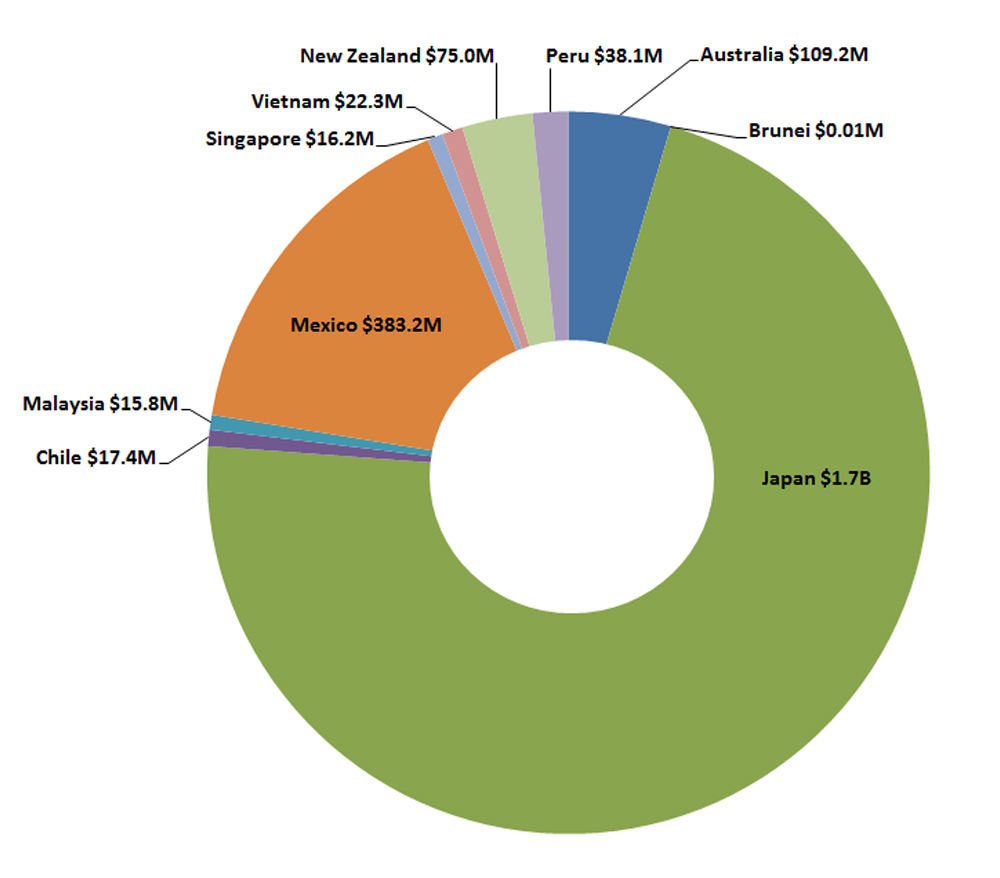What does the CPTPP mean for the forestry sector?
Summary / Overview
The CPTPP will gradually eliminate tariffs on all Canadian exports of forest and value-added wood products, creating new opportunities in key markets such as Japan, Malaysia and Vietnam.
Tariff Elimination
Canadian exports of forest and value-added wood products currently face tariffs in a number of CPTPP markets, including Japan (up to 10%), Vietnam (up to 31%), Malaysia (up to 40%), Australia (up to 5%), New Zealand (up to 5%), and Brunei (up to 20%). These tariffs hinder Canada’s competitiveness by making Canadian products more expensive.
The CPTPP will eliminate all tariffs on forest and value-added wood products, creating new opportunities for a variety of key Canadian exports, such as:
- lumber
- builders’ joinery and wood carpentry
- oriented strand board (OSB)
- plywood and veneer panels
- worked coniferous and non-coniferous wood
- sheets for veneering
- newsprint
- uncoated paper and paperboard
- carton boxes and packing containers
- sanitary and household papers
- printed materials
When the CPTPP Agreement enters into force in each relevant CPTPP market, a number of Canadian forest and value-added wood products will benefit from duty-free access, while tariffs on remaining products will be phased out over time. The longest phase-out will be 15 years for a small number of forest and value-added wood products.
How the CPTPP Benefits Exporters
The CPTPP will create new export opportunities in key markets such as Japan, Malaysia and Vietnam through the elimination of tariffs and the establishment of clear and transparent trading rules. This will allow Canadian businesses to capitalize on growing demand in the region for forest and value-added wood products.
Canada is currently the fourth-largest supplier of forest and value-added wood products to Japan, with average annual exports of $1.7 billion from 2014 to 2016.
Under the CPTPP Agreement, Canada’s forestry exports will have an advantage over exports of competitors outside the CPTPP free trade area, such as Russia and China.
By generating opportunities for Canadian forest and value-added wood products, the CPTPP will bring benefits for both Canadian businesses and workers.
Trade Snapshot
Canada is one of the world’s largest producers and is the world’s largest exporter of lumber. By value, Canada is also the world’s leading exporter of newsprint and the third-largest exporter of wood pulp.
In 2016, Canada’s forestry sector contributed close to $21.6 billion to Canada’s GDP and employed about 210,000 Canadians, including many in highly skilled jobs.
Key Facts and Figures
From 2014 to 2016, Canada’s annual exports of forest and value-added wood products to CPTPP countries averaged $2.4 billion.
Annual Canadian Forestry Exports to CPTPP Countries (2014-16 average, $CAD)

Text version
- Australia: $109.2M
- Brunei: $0.02M
- Chile: $17.4M
- Japan: $1.7B
- Malaysia: $15.8M
- Mexico: $383.2M
- New Zealand: $75.0M
- Peru: $38.1M
- Singapore: $16.2M
- Vietnam: $22.3M
CPTPP Tariff Elimination Tables
| Country | Current Maximum MFN Tariff Rate | Length of Tariff Phase-out |
|---|---|---|
| Lumber | ||
| Australia | 5% | Duty-free upon entry into force |
| Brunei | 20% | Duty-free upon entry into force |
| Japan | 6% | 15 years |
| Builders’ joinery and wood carpentry | ||
| Australia | 5% | Duty-free upon entry into force |
| Brunei | 20% | Duty-free upon entry into force |
| Japan | 5% | 8 years |
| Malaysia | 20% | Duty-free upon entry into force |
| New Zealand | 5% | Duty-free upon entry into force |
| Newsprint | ||
| Australia | 5% | Duty-free upon entry into force |
| Malaysia | 10% | 5 years |
| Vietnam | 25% | 3 years |
| Uncoated paper and paperboard | ||
| Australia | 5% | Duty-free upon entry into force |
| Malaysia | 25% | 10 years |
| Vietnam | 27% | 3 years |
| Carton boxes and packing containers | ||
| Australia | 5% | Duty-free upon entry into force |
| Malaysia | 25% | 2 years |
| Vietnam | 24% | 3 years |
| Sanitary and household papers | ||
| Australia | 5% | Duty-free upon entry into force |
| Malaysia | 25% | 5 years |
| Vietnam | 24% | 3 years |
| Printed materials | ||
| Australia | 5% | Duty-free upon entry into force |
| Malaysia | 20% | 3 years |
| Vietnam | 25% | Duty-free upon entry into force |
| Plywood and veneer panels | ||
| Australia | 5% | Duty-free upon entry into force |
| Japan | 10% | 15 years |
| Malaysia | 40% | 5 years |
| New Zealand | 5% | 7 years |
| Worked coniferous and non-coniferous wood | ||
| Australia | 5% | Duty-free upon entry into force |
| Japan | 7.5% | Duty-free upon entry into force |
| New Zealand | 5% | 7 years |
| Sheets for veneering | ||
| Australia | 5% | Duty-free upon entry into force |
| Japan | 6% | Duty-free upon entry into force |
| New Zealand | 5% | Duty-free upon entry into force |
- Date Modified: